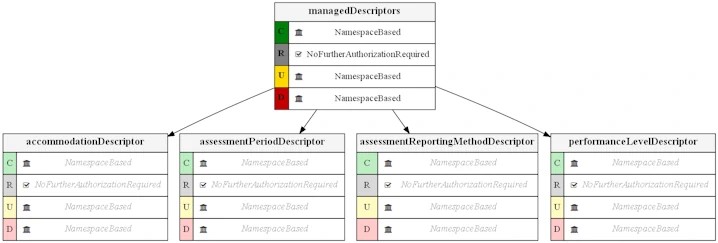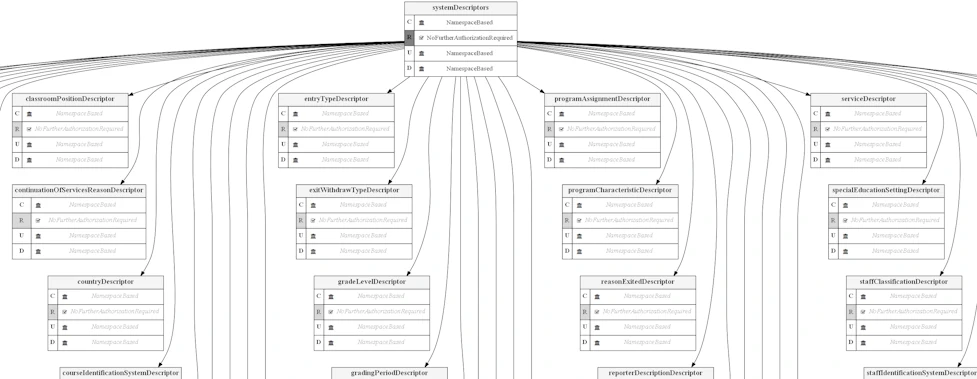Security Visualization Tool
Authorization schemes in an Ed-Fi ODS / API implementation are flexible and can be customized to serve a variety of security needs. However, the configuration metadata can be complex, which can make it difficult for administrators to understand exactly what permissions apply for a resource. The Ed-Fi ODS / API solution comes with a command-line Security Visualization Tool to help implementers visualize authorization configurations.
This section outlines how to configure and use the Security Visualization Tool. Each step is outlined in detail below.
Step 1. Install and Configure GraphViz (Optional)
The security visualization tool uses GraphVizopen source visualization software. You can install the latest stable MSI release for Windows here.
Use --graphviz command-line argument to specify the installation path; if this
argument is not specified, the tool uses C:\Program Files\Graphviz\ by
default.
The tool will automatically download and use a portable version if GraphViz is not detected in the default installation path.
Step 2. Build and Run the Security Visualization Tool
-
Start Visual Studio, open the Security Visualization Tool solution from \Ed-Fi-ODS\Utilities\GenerateSecurityGraphs\GenerateSecurityGraphs.sln, and build the solution.
-
Open a Console window and navigate to \Ed-Fi-ODS\Utilities\GenerateSecurityGraphs\GenerateSecurityGraphs\bin\Debug\net6.0.
-
Run
GenerateSecurityGraphs.exe --helpto view the parameters that can be passed to the application.PS D:\Ed-Fi-ODS\Utilities\GenerateSecurityGraphs\GenerateSecurityGraphs> .\bin\Debug\net8.0\GenerateSecurityGraphs.exe --help
GenerateSecurityGraphs 1.0.0+04569d4fea5fc8935768fdff50cf64d61da58fa7
Copyright c 2024 Ed-Fi Alliance, LLC and Contributors
-o, --out Required. The path to the folder where the graphs should be generated.
-f, --force (Default: false) Create a folder at that path if one doesn't already exist.
-c, --connectionString (Default: Server=(local);Database=EdFi_Security;Trusted_Connection=True;Encrypt=False) The
connection string for connecting to the authorization metadata database. Leave blank to
connect to the local 'EdFi_Security' database using integrated security.
-g, --graphviz (Default: C:/Program Files/Graphviz/) Graphviz installation path.
--help Display this help screen.
--version Display version information. -
Execute the tool to generate the visualizations. The example below assumes that you have followed the Ed-Fi ODS / API Getting Started steps successfully.
GenerateSecurityGraphs.exe -o "C:\graphs" -f
Step 3. Review Output
Once the tool has run, you will find a series of visualization files in the output folder you specified. There are .png and .svg versions for each schema. The root of the folder contains visualizations for the set of authorizations that are possible, and there is a sub-folder for each authorization claim set that has been configured. The as-shipped ODS / API v6.1 contains nine claim sets, resulting in nine folders.
| Type | Name |
|---|---|
| Directory | AB Connect |
| Directory | Assessment Read |
| Directory | Assessment Vendor |
| Directory | Bootstrap Descriptors and EdOrgs |
| Directory | District Hosted SIS Vendor |
| Directory | Ed-Fi ODS Admin App |
| Directory | Ed-Fi Sandbox |
| Directory | Roster Vendor |
| Directory | SIS Vendor |
| File | _icon.png |
| File | assessmentMetadata |
| File | assesmentMetadata.png |
| File | assesmentMetadata.svg |
| File | AssessmentMetadata_icon.png |
| File | educationOrganizations |
| File | educationOrganizations.png |
| File | ... etc. |
Example Output
This section provides some examples of output from the Security Visualization Tool, along with explanatory notes. An understanding of the concepts described in API Claim Sets & Resources is useful to fully understand the visualizations.
Note that the shading of font has relevance:
| Black | Indicates permissions explicitly set for the resource claim. |
| Italic gray | Indicates inherited permissions from the higher-level logical groupings in the claims taxonomy. |
| Bold black | Indicates ClaimSet level permission overrides explicitly set for the resource claim. |
| Bold italic gray | Indicates ClaimSet level permission overrides inherited from the higher-level logical groupings in the claims taxonomy. |
| Indicates a permission that has been overridden. | |
| Indicates a ClaimSet level permission from the higher-level logical groupings that has been overridden explicitly for the ClaimSet resource claim. |
Education Organizations
The diagram below shows permissions for accessing education organization entities for the "Ed-Fi Sandbox" claim set, where full Create, Read, Update, and Delete (CRUD) operations are authorized. The diagram also indicates that the authorization strategy associated with the claim is NoFurtherAuthorizationRequired.

The diagram below shows permissions for accessing education organization entities for the "SIS Vendor" claim set. In this case, it is assumed that the education agency implementing the Ed-Fi ODS / API will load and manage education organizations, so SIS vendor applications are only granted Read authorization.

Descriptors
Permissions for accessing Ed-Fi Descriptors are separated into two types: "Managed Descriptors" (managed by API clients), and "System Descriptors" (managed by the system).
The diagram below shows permissions for accessing Managed Descriptors for the "SIS Vendor" claim set. The NamespaceBased authorization strategy is applied to Create, Update, and Delete operations, which ensures that only API clients with the appropriate Namespace prefix can add or change a managed Descriptor, while the NoFurtherAuthorizationRequired strategy is applied to Read operations, meaning that other API clients read a managed Descriptor.

The diagram below shows permissions for accessing System Descriptors for the "SIS Vendor" claim set, where only Read access is allowed. (partial view only).
